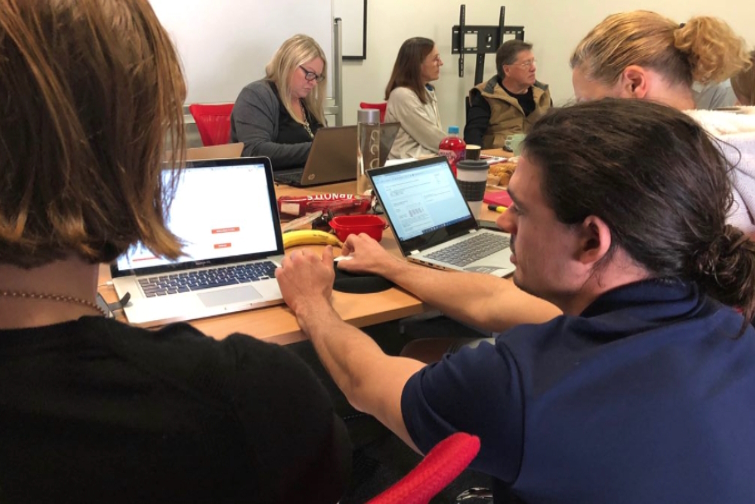Women’s annual salaries are narrowing the gap. But men still out-earn women by an average $547 a week
- Written by Leonora Risse, Associate Professor in Economics, University of Canberra

Women’s annual earnings are closing in on men’s, with the gender pay gap in Australia’s private sector shrinking from 14.5% to 13.6% in the past year.
It’s a steady improvement[1], down from a 15.4% gap two years ago.
While women are working and earning more than ever before, they are now empowered with even more information to take into salary negotiations and to decide which companies to work for.
This information is especially valuable in a tight labour market, with the unemployment rate[2] at just 4.1%, as companies fight for top talent.
This is the second year the Workplace Gender Equality Agency[3] (WGEA) has published company gender pay gaps, responding to concerns that progress on gender equality had been stalling.
Pay gap transparency tackles the problem of “asymmetric information” where employers know where each worker sits on the pay scale, but employees don’t.
Data from 7,800 private companies
Women’s typical full-time annual salaries sat at A$72,638 in 2023–24, compared to men’s $84,048.
Though narrowing, that’s still a gap of $11,410 a year, or around $220 a week.
The gap is much larger once bonuses, overtime and superannuation are included: $18,835 or a total remuneration gap of 18.3%.
All private companies in Australia with at least 100 employees must report their data to the federal agency. This covers 5.3 million employees across 7,800 companies, a big expansion from last year’s 5,000 companies as more companies improve their data reporting.
Employees can look at the agency’s website[4] to find the gender pay gap of their private sector employer – or one they are thinking of joining.
This year’s calculations of company gender pay gaps also incorporate the salaries of top executives.
When CEOs and heads of business are factored in, the difference in men’s and women’s average total remuneration swells to $28,435, or 21.8%.
This all adds up to men out-earning women by an average of $547 per week.
A closer look at company-level gender pay gaps
Across all companies, the average gender gap in total remuneration is 13.0%. But the magnitude varies widely across different companies.
Around 2,200 companies (around one-quarter) have a gap exceeding 20%. Of these, around 250 companies have a gap stretching beyond 40%.
At the other end, around one-quarter of companies have a gap that is either zero or negative, meaning in favour of women.
The agency considers a gender pay gap within the range of negative 5% to positive 5% to be a reasonable measure to aim for.
Of the largest organisations[5] (with 5,000 or more employees), airlines are among the worst performers. Virgin has an average gender gap in total remuneration of 41.7% while Qantas reports a gap of 39.2%.
Among the banks, Commonwealth Bank and Westpac both report an average gender pay gap of 22.4%. Suncorp’s gap sits at 19.3%, NAB’s is at 19.0%, and ANZ has a gap of 18.8%.
Progress is happening
The purpose of publishing company pay gap data is to propel progress on gender equality in Australian workplaces.
It follows legislated reforms[6] designed to motivate employers to pay closer attention to their gender pay gap and take more action.
Comparisons to last year’s data suggest this is happening. The agency reports that just over half of all employers (56%) reduced their gender pay gap. And 68% conducted an analysis of their gender pay gap, which is an important first step in making progress.
Greater transparency makes employers more accountable for improving working conditions.
It is also a way to recognise the companies that are improving over time and learn from their success.
Correct interpretation is critical
The gender pay gap, measured as the difference between men’s and women’s earnings, is not the same as equal pay for equal or comparable work. For over 50 years, it has been against the law[7] in Australia to pay men and women differently for doing work of equal value.
Employer-level gaps[8] in earnings reflects a combination of factors, including gender patterns in the different types of occupations that men and women tend to be in within a company. But these gender patterns in job types do not explain the whole picture.
Biases and barriers[9] persist, including unconscious favouritism, gender imbalances in care-giving responsibilities and the perpetuation of gender stereotypes.
This is also not a gap that can be explained by women working fewer hours than men. The calculations include part-time employees, whose pay is converted into an annualised full-time equivalent.
Each employer[10] has the chance to provide deeper analysis and explanation of their gender pay gap, and the actions they are taking, in their official employer statements which are also available on the agnecy’s website.
This information will empower not just current employees but also prospective employees, customers, business partners and the wider community in their choices of which companies to work for, do business with, and endorse – and which ones not to.
Read more: Now you're able to look up individual companies' gender pay gaps[11]
References
- ^ steady improvement (theconversation.com)
- ^ unemployment rate (www.abs.gov.au)
- ^ Workplace Gender Equality Agency (www.wgea.gov.au)
- ^ look at the agency’s website (www.wgea.gov.au)
- ^ largest organisations (www.wgea.gov.au)
- ^ legislated reforms (theconversation.com)
- ^ against the law (theconversation.com)
- ^ Employer-level gaps (www.wgea.gov.au)
- ^ Biases and barriers (scholar.harvard.edu)
- ^ Each employer (www.wgea.gov.au)
- ^ Now you're able to look up individual companies' gender pay gaps (theconversation.com)

















